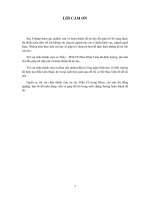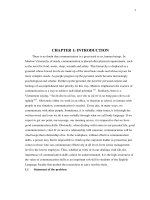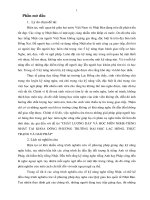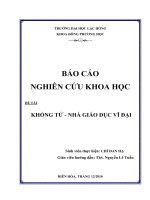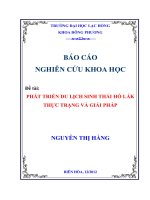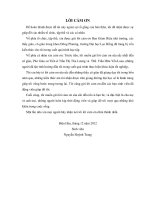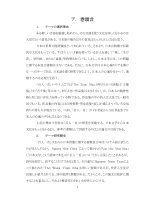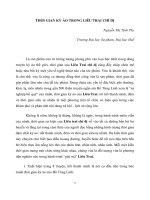Báo cáo nghiên cứu khoa học " Improving food safety in Vietnam using soilless vegetable production " pot
Bạn đang xem bản rút gọn của tài liệu. Xem và tải ngay bản đầy đủ của tài liệu tại đây (42.94 KB, 5 trang )
Improving food safety in Vietnam using soilless vegetable production
S. E. Parks and S. M. Newman, L. M. Pham, H. T. Ngo and T. K. Thi
National Centre for Greenhouse Horticulture, Fruit and Vegetable Research Institute
NSW Department of Primary Industries, Hanoi, Vietnam
Gosford, New South Wales, Australia
Key words: cocopeat, safe vegetables, vegetable quality, hydroponics
Abstract
There are food safety concerns in Vietnam in terms of pesticide and heavy
metal residues in vegetables. Soilless vegetable production is one solution to
eliminating pest and disease pressure from soil and the exposure to soil
contaminants such as heavy metals. An Australian aid project (AUSAID-CARD)
investigated the suitability of some locally available materials in Vietnam as soilless
substrates. This paper reports on the results of two experiments carried out at the
Fruit and Vegetable Research Institute in Hanoi, Vietnam. Four media were used as
substrates for the production of tomatoes and cucumbers. The media included coir,
or mixtures of three components including sugar cane waste, peanut husks, soybean,
peat or volcanic rock. For both the tomato and cucumber crop yield was
significantly increased by the use of coir as a substrate. The two crops were grown
without the use of pesticides. In this experiment, the medium of sugar cane waste,
peat and volcanic rock proved unsuitable for cucumber production as it produced
fruit with lead levels above the maximum residue limit of 0.2 mg/kg in three out of
five replicates. These results demonstrate that soilless culture can be used
successfully in Vietnam as a means of reducing residues in vegetables but highlight
that substrates can potentially be a source of contaminants.
INTRODUCTION
Vietnam has food safety issues concerning pesticide and heavy metal residues in
vegetables. These affect the health of farmers using the pesticides, and consumers eating
the vegetable products. A study conducted between 1994 and 1999 showed that 28.6% of
vegetables sampled had pesticide residues 2-6 times higher than the maximum residue
limit, and in 2001 alone, 1030 people were affected by pesticide poisoning (Thi and Ha,
2003). However, since the 1990’s the Institutions of the Ministry of Agriculture and Rural
Development have been investigating the causes, and working towards solutions to this
problem. One such institution, the Fruit and Vegetable Research Institute (FAVRI), in
Hanoi, has been interested the use of protected cropping and substrate hydroponics,
systems very new to Vietnam, as a means to reduce the dependence on the use of
pesticides in vegetable production.
It has been demonstrated in Vietnam that the use of basic shelters over field crops
reduces the reliance on pesticides (Le et al., 2003). However, for these crops that are
growing in soil, pest and disease pressure and the uptake of heavy metals, will continue to
be a problem. The adoption of soilless culture, combined with the use of shelters or
greenhouses is one way of reducing contamination of vegetables in Vietnam.
A two year Australian aid project (Ausaid-CARD) was initiated to help
Vietnamese researchers develop soilless culture systems suitable for vegetable production
in Vietnam. Two trials are reported on here that investigated the suitability of four types
of locally derived soilless substrates in the production of cucumbers and tomatoes. The
responses of cucumbers and tomatoes to the types of media were measured in terms of
yield and fruit quality.
MATERIALS AND METHODS
The trials were conducted at the FAVRI research farm in Hanoi. Tomatoes
(cultivar VL2500), and cucumber (cultivar Status), were sown on November 25 and
December 20, 2005, respectively. The tomato trial was terminated after approximately
five months and the cucumber trial after four months. The four locally derived media
mixes included medium 1(sugar cane waste, peanut husks and soybean), medium 2 (sugar
cane waste, peanut husks and peat), medium 3 (sugar cane waste, peat and volcanic rock)
and medium 4 (coir). A randomised block design was used in the greenhouse with five
replications. The experimental unit was 6 plants, growing within the row, with buffer
plants between experimental units. Before planting seedlings, substrates were placed in
grow bags. Nutrient solution was delivered via drippers. The nutrient solution input was
around 1.8 dS/m for cucumbers and 2.2 dS/m for tomatoes, depending on weather
conditions.
Yield measurements included total fruit number and total fruit weight per plant.
Quality measurements were made on 10 fruits per experimental unit and included nitrate,
vitamin C and lead concentrations, expressed on a fresh weight basis. These
measurements were carried out according to the standard methods developed at FAVRI.
RESULTS AND DISCUSSION
Yield, measured in total fruit number and fruit weight per plant, for cucumbers
(Fig. 1) and tomatoes (Fig. 2), was greatest in the coir substrate. Mean fruit weight was
also higher for cucumbers and tomatoes grown in coir (data not shown). Yield was similar
for the three other substrates. Physical and chemical characteristics of these media were
not measured, so it is not known how these characteristics may have contributed to crop
performance.
Fruit quality characteristics were affected differently by the substrates. The nitrate
concentration of cucumber fruits (Fig. 3) was generally higher than tomato fruits. As
cucumber fruit skin contains chlorophyll, it is not surprising that cucumbers have a higher
nitrate concentration than tomatoes. The chlorophyll concentration of leaves is sometimes
used to manage crop nitrate (Shapiro, 1999). Nitrate concentration was particularly high
for medium 2 (sugar cane waste, peanut husks and peat), suggesting that this medium was
contributing an additional source of nitrate to plant roots. Since this extra nitrate did not
result in extra growth by plants in this medium, nitrate was probably at supra-optimal
supply levels. Fruits generally have a lower concentration of nitrate compared with other
plant parts such as leaves and do not pose a food safety risk. However, if green leafy
vegetables were to be grown using similar substrates it would be useful to identify
potential sources of nitrate in the substrate to reduce the risk of nitrate accumulation in
vegetables.
Tomatoes were, not unexpectedly, higher in vitamin C content than cucumbers,
and highest in the coir medium, probably associated with the higher mean fruit weight for
this medium. Lead levels in fruits were of some concern. Cucumbers had generally higher
levels of lead than tomatoes. This was in contrast to the findings of Mattina et al. (2003)
for tomatoes and cucumbers grown in contaminated soil. The substrate medium 3 of sugar
cane waste, peat and volcanic rock proved unsuitable for cucumber production as it
produced fruit with lead levels above the maximum residue limit of 0.2 mg/kg in three out
of five replicates. In tomatoes, unlike cucumbers, plants produced in medium 1 had the
highest lead levels.
The tomato and cucumber substrate trials were a success in terms of
demonstrating excellent pest management. Evidence of pests and disease, including spots
on leaves, were only apparent in seven individual tomato plants. The greenhouse used,
and the management of the crop in it meant that pests were excluded and that pesticides
were not required.
CONCLUSIONS
This study has demonstrated that soilless production of vegetables is possible in
Vietnam utilising local sources of substrates. Of the substrates used in this study, coir was
associated with the highest yields and highest quality fruits. These results highlight the
need to monitor lead, and other contaminants, in vegetables produced using substrate
hydroponics as all substrates evidently can be a potential source of lead.
ACKNOWLEDGEMENTS
This work was supported by AusAID (CARD) funding.
Literature Cited
Le, T. T., Vu, T. T., Dang, H. H., Ngo, H. T., Nguyen, C. K., Vu, H. T. and Nguyen, H.
D. 2003. Off-season tomato and year-round vegetable production under shelter in
Hanoi. Report: Sustainable Development of Peri-urban Agriculture in South-East
Asia.
Mattina, M. J. I.; Lannucci-Berger, W.; Musante, C.; White, J. C. Concurrent plant uptake
of heavy metals and persistent organic pollutants from soil. Environmental Pollution.
Elsevier Science Ltd, Oxford, UK: 2003. 124: 3, 375-378. 9 ref.
Shapiro, C. A. 1999. Using a chlorophyll meter tom managem nitrogen application sto
corn with high nitrate irrigation water. Com. Soil Sci. and Plant Anal. 30:1037-1049.
Thi, T. K. and Ha, T. T. T. 2003. Safe vegetable research and development in Vietnam:
status and prospective. Vietnam J. of Ag. and Rural Devel. 1:115-118.
Figures
0
0.5
1
1.5
2
2.5
3
3.5
1234
Growing medium
Total fruit weight/plant (kg)
0
5
10
15
20
25
30
35
40
1234
Growing medium
Fruit number/plant
Figure 1. Cucumber production in the four medium types, mean total fruit weight (left)
and number (right) per plant, n= 5, bars represent standard error.
0
0.5
1
1.5
2
2.5
3
3.5
4
4.5
1234
Growing medium
Fruit weight/plant (kg)
0
5
10
15
20
25
30
35
40
1234
Growing medium
Fruit number/plant
Figure 2. Tomato production in the four medium types, mean total fruit weight (left) and
number (right) per plant, n= 5, bars represent standard error.
0
20
40
60
80
100
120
140
1234
Growing medium
Nitrate concentration (mg/kg)
Cucumber
Tomato
Figure 3. Mean nitrate concentration of cucumber and tomato fruits, n= 5, bars represent
standard error.
0
5
10
15
20
25
1234
Growing medium
Vitamin C content (mg)
Cucumber
Tomato
Figure 4. Mean vitamin C concentration of cucumber and tomato fruits, n= 5, bars
represent standard error.
0
0.05
0.1
0.15
0.2
0.25
1234
Growing medium
Lead concentration (mg/kg)
Cucumber
Tom ato
Figure 5. Mean lead concentration of cucumber and tomato fruits, n= 5, bars represent
standard error.
